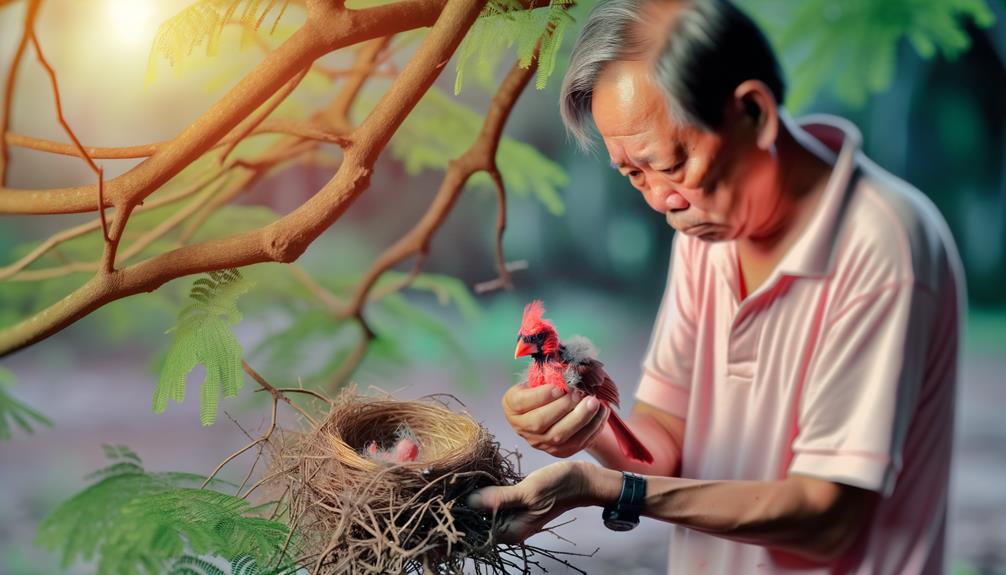5 Steps to Help a Baby Cardinal That Fell Out of Its Nest
If a baby cardinal fell out of its nest, first check for injuries like bleeding or broken wings. If it's hurt, contact a wildlife rehabilitator immediately.
Determine the bird's age to decide if it needs assistance or if its parents can still provide care. Scan the area for its nest, typically located in trees or bushes.
Gently place the bird back in its nest using clean hands or a soft cloth. If the nest is unreachable, create a makeshift one nearby.
Keep an eye out for the parents' return. Want to guarantee the best outcome for the baby bird?

Key Takeaways
- Assess the baby cardinal for visible injuries like bleeding or broken wings before intervening.
- Determine the bird's age to decide if it needs immediate help or can be cared for by its parents.
- If uninjured, locate and return the baby cardinal to its nest or create a makeshift nest nearby.
- Handle the bird gently with clean hands or a soft cloth and observe from a distance for parental return.
- Contact a wildlife rehabilitator if the bird shows signs of injury, illness, or abnormal behavior.
Assess the Situation
When you find a baby cardinal on the ground, the first step is to calmly assess its condition and immediate surroundings. Look for any visible injuries such as bleeding, broken wings, or difficulty breathing. If the bird appears hurt, you might need to contact a wildlife rehabilitator.
Next, check the environment for potential dangers like predators, busy roads, or extreme weather. Verify the area is safe before proceeding.
Observe the bird's behavior; if it's chirping and active, it could be calling for its parents, who may be nearby. Take a moment to look for the nest; it might be in a nearby tree or bush.
Your calm and careful evaluation is essential for the bird's safety and well-being.
Identify the Bird's Age
Determining the baby cardinal's age will help you decide the best course of action for its care and possible return to its nest. Look at its feathers: a hatchling has little to no feathers and closed eyes, while a nestling has some feathers and open eyes but isn't ready to leave the nest.
A fledgling, on the other hand, has most of its feathers and may be able to hop or flutter short distances. Fledglings are often found on the ground as they learn to fly. Identifying whether it's a hatchling, nestling, or fledgling is essential to knowing if it needs immediate intervention or can be safely watched from a distance as its parents care for it.
Check for Injuries
Before taking any further action, carefully examine the baby cardinal for signs of injuries such as bleeding, broken bones, or labored breathing. Gently hold the bird and look for any visible wounds or abnormalities. Check the wings and legs to make sure they're not bent in awkward positions. Observe its breathing; if it's rapid or strained, the bird may be in distress.
If you notice any serious injuries, contact a wildlife rehabilitator immediately. Minor scrapes or missing feathers usually aren't critical but still require attention. Handle the bird as little as possible to reduce stress. Keep it warm by placing it in a small box lined with soft cloth until you can get professional help.
Locate the Nest
Finding the baby cardinal's nest is essential to reuniting it with its family and ensuring its best chance of survival.
Start by scanning the immediate area around where you found the bird. Look up into trees, bushes, and other high places, as cardinals often build nests 3-10 feet off the ground. Pay close attention to any chirping or movement that might indicate the presence of other baby birds or the parents.
If the nest isn't immediately visible, take a broader look while staying within a reasonable radius. Remember, patience is key. Avoid disturbing other wildlife or damaging vegetation.
Safely Return the Bird
Gently pick up the baby cardinal with clean hands or a soft cloth to avoid transferring any oils or scents that could deter the parents. Carefully place the bird back into its nest, making sure it's secure and comfortable.
If the nest is out of reach, you can create a makeshift nest using a small basket lined with soft materials, like tissue or grass. Attach this basket to a tree branch close to where you found the baby, ideally within sight of the original nest.
Observe from a distance to confirm the parents return. Typically, they'll resume care once they see their chick is safe. Be patient and give them time to recognize and respond to their baby.
When to Contact a Professional
If the baby cardinal shows signs of injury, illness, or you've been unable to reunite it with its parents, it's time to contact a wildlife rehabilitator. Look for wounds, difficulty breathing, lethargy, or any other abnormal behavior. Wildlife rehabilitators are trained to handle such situations and can provide the necessary care.
You can find a local rehabilitator through online resources or by contacting your nearest animal control or veterinary office. While waiting for help, keep the bird in a quiet, warm place away from pets and children. Avoid feeding or giving it water, as improper care can do more harm than good.
Your prompt action can make a significant difference in the baby cardinal's recovery.
Conclusion
You've done a great job by evaluating the situation and identifying the baby cardinal's needs. If you've safely returned it to its nest and confirmed it's uninjured, then you're on the right track.
But remember, when in doubt, contacting a professional is like calling tech support for nature. They're there to help. Trust your instincts, stay compassionate, and always prioritize the bird's well-being.
You're now better equipped for any feathered friends in need.






